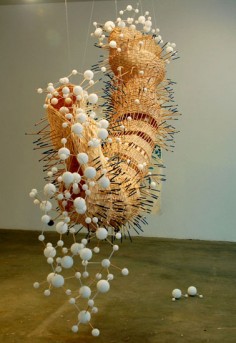Nathalie Miebach
source: opusarting365
Nathalie Miebach,美国艺术家。
Nathalie Miebach的作品致力于艺术和科学的结合。用气象学和各学科的工序,诠释有关于天文学,生态学和气象运动的科学数据的雕塑。主要用织造的方式来表达,特别是篮筐织造。.
.
.
.
.
.
.
.
source: treehugger
In a world of ever-increasing information flow, we can’t seem to get enough of diagrams and interactive maps that help us better organize and understand our world. Artist Natalie Merbach’s fascinating sculptures — which translate ecological, astronomical and meteorological data into physically woven, basket-like structures — will certainly delight those of us who have ever marvelled at how complex information can be beautiful (you could call it baskets for information geeks).Using materials like reed and the metered grid of basket-weaving to interpret raw data over time into three dimensions, each weave in Merbach’s pieces represents one hour. Wired UK describes Merbach’s unusually methodological creative process:
Miebach likes to collect the data herself, spending hours and days in the field trying to understand complex, dynamic relationships between different variables in an environment.
Keeping an eye on things like cloud cover, animal behaviour, water currents, and even less tangible factors like the smell of the air and feel of the ground below your feet, can give a clue to how hundreds of systems can interoperate in one place. “I keep describing this as a type of visual ‘listening’ with my peripheral vision, though I am still learning what that actually means,” she said.
In her artist statement, Miebach describes her work as a meshing of the lines between the scientific and artistic disciplines:
Central to this work is my desire to explore the role visual aesthetics play in the translation and understanding of science information. By utilizing artistic processes and everyday materials, I am questioning and expanding boundaries through which science data has been traditionally visually translated (ex: graphs, diagrams), while at the same time provoking expectations of what kind of visual vocabulary is considered to be in the domain of ‘science’ or ‘art’.
Merbach’s most recent work, “Recording and Translating Climate Change” involves the gathering of climate data using simple data-collecting devices. The collected information is compared to global and historical trends and translated into sculpture and even musical scores. In the end, Merbach’s goal is not about presenting hard science, but about “convey[ing] a nuance or level of emotionality” that’s usually absent — even though emotions themselves are a kind of information that’s equally worthy of attention..
.
.
.
.
.
.
.
source: nathaliemiebach
My work focuses on the intersection of art and science and the visual articulation of scientific observations. Using the methodologies and processes of both disciplines, I translate scientific data related to astronomy, ecology and meteorology woven sculptures. My method of translation is principally that of weaving – in particular basket weaving – as it provides me with a simple yet highly effective grid through which to interpret data in three-dimensional space. By staying true to the numbers, these woven pieces tread an uneasy divide between functioning both as sculptures in space as well as instruments that could be used in the actual environment from which the data originates.
Central to this work is my desire to explore the role visual aesthetics play in the translation and understanding of science information. By utilizing artistic processes and everyday materials, I am questioning and expanding boundaries through which science data has been traditionally visually translated (ex: graphs, diagrams), while at the same time provoking expectations of what kind of visual vocabulary is considered to be in the domain of ‘science’ or ‘art’.
For my most recent project called “Recording and Translating Climate Change”, I gather weather observations from specific ecosystems using very simple data-collecting devices. The numbers are then compared to historical / global meteorological trends, before being translated into sculpture. By examining the complex behavioral interactions of living/non-living systems between weather and an environment, I hope to gain a better understanding of complexity of systems and behaviors that make up weather and climate change. Lately, I have also started to translate the data into musical scores, which are then interpreted through sculptures as well as through collaborations with musicians. My aim is twofold: to convey a nuance or level of emotionality surrounding my research that thus far has been absent from my visual work and to reveal patterns in the data musicians might identify which I have failed to see.


